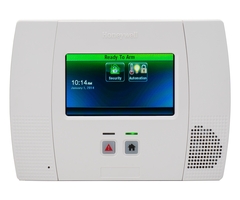How do I test a Honeywell 5800PIR-RES motion detector?
To test the Honeywell 5800PIR-RES either power the unit up for the first time, or remove and re-insert the batteries. This begins a 10-minute walk test mode. During this time, the motion will light the red LED every time it senses motion and will transmit every fault to the alarm panel.
When the Honeywell 5800PIR-RES wireless motion sensor is first removed from the box and powered up the red LED will flash each time motion is sensed for the first ten minutes. After that, the test mode will end, and the LED will never flash again unless a new test mode is initiated. The 5800PIR-RES is a popular, versatile device with a 35 by 40 foot coverage area. This device is "pet-friendly" and safe to use with pets up to 80 pounds, as long as all installation guidelines pertaining to pet immunity are followed.
When testing the motion, it is important to note the difference between the panel's test mode, and the motion detector's test mode. To enter walk-test mode on the panel, you will enter a command on the keypad. Refer to the installation instructions for your particular panel for instructions. When the panel is in test, it will indicate on the keypad that walk-test is active, and will sound a single beep about every 40 seconds as a reminder that it's in test mode As each zone is faulted, including motion detectors, a chime will sound at the panel, indicating that a fault from a device was recognized. If the panel or keypad is capable of voice, and voice is enabled, the zone description will also be spoken. Panel test mode, and motion test mode are two separate things, and each must be activated separately. In addition, there are two more features that affect the testing of any** Honeywell wireless motion detector: Transmission Lockout and Auto-stay Arming.
Like all Honeywell RF sensors, the 5800PIR-RES is optimized for long battery life. Batteries in these devices can last 5 years or more, depending on usage. In order to attain this lengthy battery life, Honeywell uses a "Transmission Lockout" technology which is designed to minimize the number of times the motion detector transmits a wireless signal. When not in test mode, the 5800PIR-RES will transmit a fault no more than once every three minutes. This lockout is active whether the system is armed or disarmed, and can only be disabled by putting the motion detector into test mode. Test mode will never last more than 10 minutes. The idea behind this lockout is that most break-ins will not occur within the first three minutes of arming. Once the system has been armed and the lockout has expired, the first motion detected by the 5800PIR-RES will transmit and cause an alarm, as long as the motion is not bypassed. The other important feature to consider while testing your motion detector is what is known as "Auto-stay Arming."
Auto-stay arming is a feature that is enabled by default on the LYNX Touch L5200 and L7000 alarm systems. It can be disabled under 'System Settings' in panel programming. This technology is designed to prevent false alarms if you arm 'Away' but do not exit the home. When 'Auto-stay Arming" is enabled, if you arm the system 'Away', but the panel doesn't see an Entry/Exit zone open and close during the exit delay time, the system assumes you did not leave, and that you really meant to 'Arm Stay'. At the end of the exit delay, it will automatically switch to 'Stay'. Often, when attempting to test motion detectors, a person will arm 'Away' then wait inside for the exit delay to expire. Unfortunately, this then causes the system to switch to 'Stay' which automatically bypasses the motion detectors.
The way to trick the system and test the motion with this feature enabled is to do the following: Arm away, open and close an entry door (zone set to entry/exit delay), wait for the exit delay to expire, then trip the motion. You will still need to consider the transmission lockout if you have walked in front of the motion within the last 3 minutes. If you are using a key fob or the Total Connect 2.0 app, the system realizes you may be arming remotely or outside the home and disables Auto-stay arming.
All in all, it is best to first use the alarm system's test mode in conjunction with the motion detector's test mode to verify the motion is properly reporting faults. Then walk-test the motion by arming away and keeping in mind the transmission lockout (battery saving timeout period) and auto-stay mode. You may find that the motion detector that did not seem to work reliably actually works very well and should last many years on a single battery!
**Please note: The 5800PIR-OD outdoor wireless motion uses the position of dip switch 2 to determine the length of the transmission lockout: 5 seconds or 2 minutes.**
Did you find this answer useful?
We offer alarm monitoring as low as $10 / month
Click Here to Learn MoreRelated Products

Related Videos
Related Categories
- Answered
- Answered By
- Frank Longo


